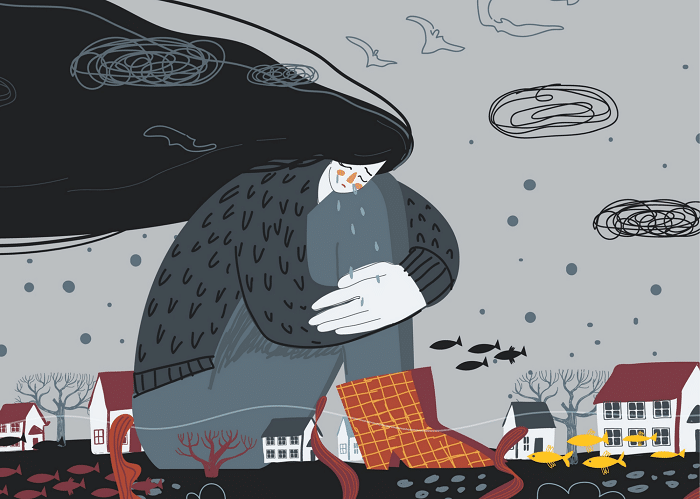A survey taken in August of 2020 by the Center for Disease Control and Prevention showed that 1 in 4 young adults have considered suicide. Pretty heavy, right? Truthfully, over half of us have been affected by it at one point in our lives. Globally, suicide claims more lives than war, murder, and natural disasters combined.
Listen as one family shares the story of the loss of their daughter, Alexandra Valoras, a straight-A student, class officer, and robotics whiz.
September is Suicide Prevention Awareness Month. Over the next four weeks, we’re exploring the topic of suicide. And this week? We’re taking a closer look at the risk and protective factors.
Risk Factors
Prior Suicide Attempts
For every death by suicide, there is an average of 25 attempts.
Mental Health Conditions
According to the American Foundation for Suicide Prevention, 90% of people who died by suicide had a diagnosable mental health condition.
Populations at the highest risk include:
Depression: The lows that come alongside this condition often make it hard for people to see a way out—up to 60% of those who die by suicide experience clinical depression.
Bipolar Disorder: Both manic and depressive episodes carry an increased risk. Ultimately, 1 in 5 people with bipolar disorder will die by suicide, shortening the average lifespan by up to 17 years.
Schizophrenia: Sadly, up to 13% of people with schizophrenia will die by suicide. Psychosis, along with a myriad of other factors, contribute to this heartbreaking statistic.
Lack of Access to Mental Health Care
Risk of suicide among those experiencing a mental health condition significantly increases without treatment.
Substance Abuse
Misuse of drugs and alcohol enhances the likelihood of completed suicide because it impairs judgment and increases impulsive behavior.
Prolonged Stress
Harassment, bullying, relationship problems, and unemployment all elevate the risk of suicide.
Significant Life Events
Rejection, divorce, financial crisis, life transitions such as retirement, and experiencing grief and loss all carry an increased likelihood for suicide.
Social Isolation
Studies show that social isolation is associated with depression, anxiety, and enhanced risk for suicide. Overall, loneliness increases the chance of premature death from all causes, a risk factor that rivals that of smoking, obesity, and physical inactivity.
Physical Health Conditions
A study in Britain found that roughly 10% of suicides are linked to terminal or chronic illness.
Access to Lethal Means
85% of suicide attempts with a gun are fatal, versus 4% using other means. Among youth, secure storage of firearms can significantly reduce suicide risk.
Recent Loss by Suicide
Having a friend or family member die by suicide considerably heightens risk.
Protective Factors
Protective factors are personal or environmental characteristics that help protect people from suicide.
Major protective factors for suicide include:
- Effective behavioral health care
- Connectedness to individuals, family, community, and social institutions
- Life skills (including problem-solving skills and coping skills, ability to adapt to change)
- Self-esteem and a sense of purpose or meaning in life
- Cultural, religious, or personal beliefs that discourage suicide
Learn More: Warning Signs of Suicide
What to Do if Someone Is Struggling
If you’re concerned, don’t be afraid to pop the question. It’s important to ask about thoughts of suicide. Many people feel that by asking the question, they might plant the idea in someone’s mind, but that’s far from true. Many people find it relieving to talk about their struggles and are grateful for the people who reach out to support them.
Learn More: How to Talk to Someone About Suicide
If someone reports that they are considering suicide, it’s critical to help them get support. For those who have immediate plans and means, someone should stay with them until they are safe. They will need to go to the emergency room to be evaluated by a mental health professional. If they’re in immediate danger, you should call 911.
Learn More: Responding to Suicide Warning Signs
If you have a child who is struggling, know that we’re here to help. We provide mental health support to youth and families within a sixty-mile radius of all our 30 locations across Montana. To learn more, contact us through our website or call 406-245-6539 for more information.
Are You Struggling?
You don’t need to bear the heavy weight of sadness without support. It might feel like you’re alone in your struggles, but there are people who care and want to help. Call a friend or family member, and don’t be afraid to reach out to the National Suicide Prevention Lifeline by dialing 988.
Want to Learn More?
If you enjoyed this article, check out the rest of our blog today, and make sure to follow us on social media. You can find us on Instagram at youthdynamicsmt, and Facebook at Youth Dynamics of Montana, and People of Youth Dynamics.





